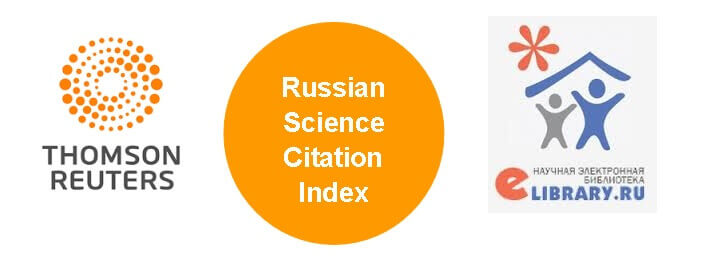About the using of chromatographic terms and concepts in the English language articles on the topic «Chromatography»
Abstract
Chromatography has been actively developed and applied for the scientific research for over 100
years. The theme of the chromatographic lexics is of great importance for various areas of chemistry,
particularly for physical and analytical chemistry. Chromatography is used all over the world in the scientific research, industry, medicine, pharmaceuticals, forensic studies, environmental control etc. The universal language of the intercultural communication, the language of the internationally significant scientific publications, the so-called ‘lingua franca’, is English. In order to analyze the language picture of
chromatographers, the frequency of using of the main chromatographic terms and concepts in Anglophone articles in the area of chromatography has been investigated. The method of calculation has been based onthe statistical description of the number of terms used in the articles. The statistical data of the global citation database “Web of Science Core Collection” has been analyzed. The paper presents the description of the chromatographic term-system and the core terms. A term-system is an ordered set of terms with particular relations inside the system. Any term-system might serve as a basis for composing a dictionary or for the work of a scientific interpreter. The schematic description of the scientific picture that reflects the core of the linguistic consciousness of a chromatographer as a researcher has been proposed. The sense of a word or a term constructs a semantic net, which might serve as a basis of linguistic consciousness. The scientific picture of a chromatographer is reflected by the chromatographic vocabulary. In the other words, the studied terms and concepts let us virtually “construct” the scientific picture of a chromatographer, which reflects the (mental) lexicon and linguistic consciousness. The core (central) and peripheral scientific lexics permits a chromatographer to operate with all the all the necessary terms and concepts. The description of the vocabulary shows the structure of the science of chromatography. A scientific picture can be represented as a complicated many-layers model. The core of the linguistic consciousness reflects the objective experience of chromatographers, while the peripheral terms refer to more subjective scientific experience. Common language terms such as “mass”, “analysis”, and “determination” reflect the philosophic facets of a chromatographer’s scientific activity. The frequency of using of the main sub-sciences of chromatography - GC, LC, TLC - mentioned in the studied articles has been considered by the authors. This research is of interest for translation, as well as for reading and analyzing of scientific literature in the area of chromatography.
References
1. Tswett M.S. Selected works (Izbrannyye Trudy) / Ed. By Yu.A.Zolotov. M., Nauka, 2013, 679 p.
2. Berezkin V.G. Vvedeniye v khromatografiyu, M., Nauchny Mir, 2016, 96 p.
3. Khromatografia: (Osnovnye ponyatia. Terminologia). RAS, Committee on Terminology
in the sphere of Fundamental Sciences, Scientific Council on chromatography, Compendium
on scientific-normative terminology, Is. 114, M., 1977 pp. 7-12.
4. Berezkin V.G., Journal of Analytical Chemistry. 2001. Vol. 56, No 8, pp. 871.
5. Berezkin V.G., Gavrichev V.S., Kolomiyets L.N., Korolev A.A. et al., Gazovaya
khromatografiya v neftekhimii, M., Nauka, 1975, 271 p.
6. PAC, (Nomenclature for chromatography (IUPAC Recommendations)), 1993, 65, pp. 819, 823.
7. Web of Science Core Collection, Available at: [https://apps.webofknowledge.com/
WOS_GeneralSearch_input.do?product=WOS&search_mode=GeneralSearch&SID=F6Jeoan1
DdgmtJlOcGE&preferencesSaved=] (accessed 20.12.19).
8. Lingvistichesky entsiklopedichesky slovar’ / Ed. by V.N.Yartseva, M., Sovetskaya entsiklopedia,
1990, 685 p.
9. Ufimtseva N.V., Yazyk v prostranstve rechevykh kul’tur (By the 80th anniversary of E.V.Gol’din), Moscow-Saratov, Nauka obrazovaniya, 2015, pp. 335-342.
10. Zalevskaya A.A., Vvedeniye v psikholingvistiku, M., RGGU, 1999, 382 p.
11. Ufimtseva N.V., Yazyk I metod: Russky yazyk v lingvisticheskikh issledovaniyakh XXI veka, Vol.2, Lingvistichesky analiz nag rani metodologicheskogo sryva / Ed. by D.Shumska, K,Ozga, Krakov, Wydawnictwo Uniwersytetu Jagiellońskiego, 2015, pp. 249-256.
12. Ufimtseva N.V., Balyasnikova O.V., Vestnik VolGu, Series 2, Yazykoznaniye, 2019, Vol. 18, No 1, pp. 6-22.
13. Krongauz M.A. Semantika, M., Akademiya, 2005, 352 p.
14. Vasilyev L.M., Voprosy yazykoznanya, 1971, No 3, pp. 105-113.
15. Russky yazyk: Encyclopedia / Ed.by Yu.N.Karaulov, Moscow, Bol’shaya rossiyskaya entsiklopediya, Drofa, 1997, 704 p.
16. Hornby P.A. et al. Bilingualism - Psychological, Social and Educational Implications. New York, San Francisco, London, Academic Press Inc., 1977, 167 p. (in the lectures of T.V. Chernigovskaya, online course, on online platform “Otkrytoye obrazovaniye”, 2017, Available at:
[https://openedu.ru/course/spbu/PSYLING/] (accessed 23.12.19)
17. Ter-Minasova S.G. Yazyk i mezhkul’turnaya kommunikatsiya, M., Slovo, 2000, 624 p.
18. Hoffmann L. Fachsprachen und Gemeinsprache. Handbucher zur Sprach- und Kommunikationswissenschaft. Band 14.1, (Fachsprachen. Ein internationales Handbuch zur Fachsprachenforshung und Terminologiewissenschaft), 1, Berlin - New York, Walter de Gruyter,
1998, pp. 157-167.
19. Markovina I.Yu., Voprosy psikholingvistiki, 2011, Vol. 2, No 14, pp. 48.
20. Vanyukhina M.A., Professionally oriented translation: reality and prospects: Collection book of scientific works on materials of the 4th International scientific-methodological conference, devoted to the 50th Anniversary of PFUR, 20-21 of May, 2009, Moscow, PFUR, pp. 101-109.
21. Seredin A.A., Youth and Science: Collection book of materials of VIII All-Russia scientific-
technical conference for students, postgraduates and young scientists, devoted to the
155th anniversary of K.E. Tsiolkovsky, 19-27 of April, 2012, Ministry of Education and Science
of the Russian Federation, The Siberian Federal University, Krasnoyarsk, 2012, pp. 50-53.
22. Gak V.G., Grigoriyev B.B. Teoriya i praktika perevoda. Frantsuzsky yazyk, M., URSS, 2019, No 12, pp. 5-20.
23. Stepanov Yu.S. Frantsuzskaya stilistika, M., Vysshaya shkola, 1965, 355 p.
24. Markovina I.Yu., Sorokin Yu.A. Kul’tura i tekst, Vvedeniye v lakunologiyu, M., GEOTAR-
Media, 2008, pp. 4-8.
25. Barkhudarov L.S. Yazyk i perevod. Voprosy obshchey I chastnoy teorii perevoda, M.,
«Mezhdunarodnye otnosheniya», 1975, 240 p.
26. Vlakhov S.I., Florin S.P. Neperevodimoye v perevode, M., R.Valent, 2012, 406
p.(translated from Bulagarian).
27. Duplensky N.K. Pis’meny perevod. Rekomendacii perevodchiku, zakazchiku i redaktoru,
M. R.Valent, 2013, 164 p.
28. Klimzo B.N. Remeslo tekhnicheskogo perevodchika. Ob angliyskom yazyke, perevode
i perevodchikakh nauchno-tekhnicheskoy literatury, M., R.Valent, 2011, 488 p.
29. Corradini D. Handbook of HPLC. CRC Press, Taylor and Francis Group, Boca Raton-
London-New York, 2011, 696 p.
30. Hahn-Deinstrop E. Applied Thin-Layer Chromatography. Best Practice and Avoidance
of Mistakes. Weinheim, Wiley-VCH, 2007, Vol. 16, 314 p.
31. Nyiredy Sz. (ed.) Planar Chromatography. A retrospective view for the third millennium,
Budapest, Springer Sci. Publ., 2001, 614 p.
32. Raymond P.W. Scott. Liquid chromatography. Column Theory. Chichester-New York-
Brisbane-Toronto-Singapore, John Wiley&Sons, 1991, 292 p.
33. Berezkin V.G., Zeuuw J.de. Capillary adsorption gas chromatography. Heidelberg, Huethig,
1996, 320 p.
34. Guiochon G., Guillemin C. Quantitative Gas Chromatography for Laboratory Analyses
and On-Line Process Control, Amsterdam, Elsevier Science, 1988, Vol. 42, 796 p.
35. Vanyukhina M.A., Berezkin V.G. English-Russian and Russian-English Dictionary on
Thin-Layer Chromatography (TLC) (with Application of Russian-English vocabulary of general
scientific phrases), Moscow, Scientific World (Nauchny Mir), 2018, 214 p.
36. Misuno E.A., Batsenk I.V., Vdovichev A.V., Ignatova S.A., Pis’menny perevod spetsial’nykh
tekstov, M., Flinta, Nauka, 256 p.
37. Vanyukhina M.A., Xth International scientific and practice conference of young
scientists “Actual problems of linguistics and cross-cultural communication”, 12 of May,
2010, Yekaterinburg, UGTU-UPI, 287 p.
38. Pumpyansky A.L. Vvedeniye v praktiku perevoda, M., Nauka, 1965, 304 p.
39. Khrebtova S.S., Berezkin V.G., Journal of Planar Chromatography, 2019, Vol. 32, pp.
355-358, DOI 10.1556/1006.2019.32.5.1.
40. Filosofiya: Encyclopedical dictionary / Ed. by A.A. Ivin, M., Gardariki, 2004, 1072 p.






